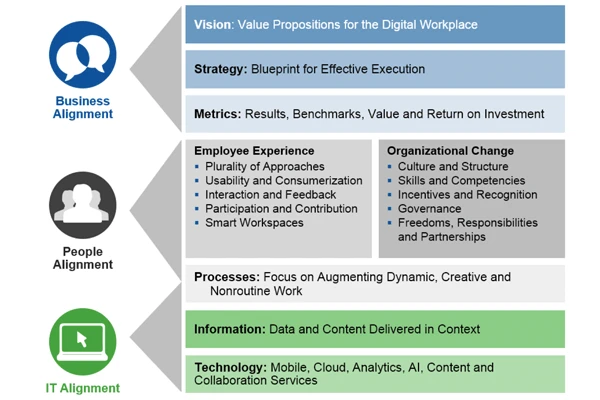Energy Wastage and Vertical Solutions to Drive Surge in Industrial Smart Buildings Deployments
Juniper Research forecasts that global industrial smart building deployments will grow from 26 million in 2025 to over 165 million by 2030.

Digital workplace programs often lose their way, or fail, due to a fragmented approach that prioritizes a few technology "fixes" over business strategy, said Gartner. To combat this, digital workplace leaders need to employ a framework to ensure their digital workplace initiatives address all of the eight critical components required for a successful implementation.
"The digital workplace promises a more flexible, engaging and intelligent work environment that is able to exploit changing business conditions," said Carol Rozwell, vice president and distinguished analyst at Gartner. "To be successful, a digital workplace can't be built in a vacuum. It must be part of a wider business strategy that seeks to boost employee agility and engagement by developing a more consumerized work environment.
Gartner has identified the eight critical components, "building blocks", that application leaders need when planning, directing and evolving digital workplace programs.

Source: Gartner (August 2017)
1. Vision: Describe What Digital Workplace Success Will Look Like
The vision describes the future state of the digital workplace and how it will benefit all stakeholders. It should be consistent with the organization's values and serve as a source of inspiration to the stakeholders who will craft the strategy and tactics to realize the vision.
2. Strategy: Create a Roadmap to Reach the Destination
The strategy describes the approach an organization will use to achieve its vision and create a digitally empowered workforce. It clearly defines the strategic roadmap to achieve the organization's business goals.
3. Metrics: Measure Performance and Value
How application leaders of digital workplace programs measure the value of their initiatives should be an extension of the organization's current approach. Each initiative should be designed to have a positive impact on a business value metric, such as workforce effectiveness, employee agility, employee satisfaction and employee retention. Effective metrics also provide a feedback mechanism for continuous development of strategy and tactics, serve as great tools for change management, and help structure employee incentives.
4. Employee Experience: Design for Improved Employee Interaction
Creating an excellent employee experience is a pivotal aspect of a digital workplace. An engaged, creative and energetic workforce outperforms the competition in terms of service delivery, execution and product design. "The aim should be to increase employees' participation in any workplace redesign, in order to create an environment that will make them more effective and connect them better to the outcomes of the business," said Rozwell.
5. Organizational Change: Start Small but Think Big
As digital workplace initiatives mature, they require considerable change to an organization's internal processes, departmental structures, incentives, skills, culture and behavior. Ultimately, digital workplace initiatives will affect every system, process and role within the organization.
6. Processes: Re-engineer How High-Impact Work Is Done
Digital workplace programs are particularly powerful when they set their sights on increasing the effectiveness of people who do high-impact work. Such work benefits from more agile, responsive and collaborative processes that rely more on the ability to respond rapidly to changing circumstances. Re-engineering business processes requires a close look at how employees currently work, in order to design new work journeys. The new and improved ways of working will involve the addition of new tools to enable collaborative work, use of other new technologies and adaptation of outmoded processes.
7. Information: Rework Access and Use of Content and Analytics
Workers expect enterprise tools for searching, sharing and consuming information to be as "smart" and compelling as those they use in their personal lives. They want information and analytics to be contextualized, based on their work, and delivered when they need it. By 2020, algorithms will improve the behavior of over 1 billion workers.
Digital workplace programs often lose their way, or fail, due to a fragmented approach that prioritizes a few technology "fixes" over business strategy, said Gartner. To combat this, digital workplace leaders need to employ a framework to ensure their digital workplace initiatives address all of the eight critical components required for a successful implementation.
"The digital workplace promises a more flexible, engaging and intelligent work environment that is able to exploit changing business conditions," said Carol Rozwell, vice president and distinguished analyst at Gartner. "To be successful, a digital workplace can't be built in a vacuum. It must be part of a wider business strategy that seeks to boost employee agility and engagement by developing a more consumerized work environment.
Gartner has identified the eight critical components, "building blocks", that application leaders need when planning, directing and evolving digital workplace programs.
Source: Gartner (August 2017)
1. Vision: Describe What Digital Workplace Success Will Look Like
The vision describes the future state of the digital workplace and how it will benefit all stakeholders. It should be consistent with the organization's values and serve as a source of inspiration to the stakeholders who will craft the strategy and tactics to realize the vision.
2. Strategy: Create a Roadmap to Reach the Destination
The strategy describes the approach an organization will use to achieve its vision and create a digitally empowered workforce. It clearly defines the strategic roadmap to achieve the organization's business goals.
3. Metrics: Measure Performance and Value
How application leaders of digital workplace programs measure the value of their initiatives should be an extension of the organization's current approach. Each initiative should be designed to have a positive impact on a business value metric, such as workforce effectiveness, employee agility, employee satisfaction and employee retention. Effective metrics also provide a feedback mechanism for continuous development of strategy and tactics, serve as great tools for change management, and help structure employee incentives.
4. Employee Experience: Design for Improved Employee Interaction
Creating an excellent employee experience is a pivotal aspect of a digital workplace. An engaged, creative and energetic workforce outperforms the competition in terms of service delivery, execution and product design. "The aim should be to increase employees' participation in any workplace redesign, in order to create an environment that will make them more effective and connect them better to the outcomes of the business," said Rozwell.
5. Organizational Change: Start Small but Think Big
As digital workplace initiatives mature, they require considerable change to an organization's internal processes, departmental structures, incentives, skills, culture and behavior. Ultimately, digital workplace initiatives will affect every system, process and role within the organization.
6. Processes: Re-engineer How High-Impact Work Is Done
Digital workplace programs are particularly powerful when they set their sights on increasing the effectiveness of people who do high-impact work. Such work benefits from more agile, responsive and collaborative processes that rely more on the ability to respond rapidly to changing circumstances. Re-engineering business processes requires a close look at how employees currently work, in order to design new work journeys. The new and improved ways of working will involve the addition of new tools to enable collaborative work, use of other new technologies and adaptation of outmoded processes.
7. Information: Rework Access and Use of Content and Analytics
Workers expect enterprise tools for searching, sharing and consuming information to be as "smart" and compelling as those they use in their personal lives. They want information and analytics to be contextualized, based on their work, and delivered when they need it. By 2020, algorithms will improve the behavior of over 1 billion workers.